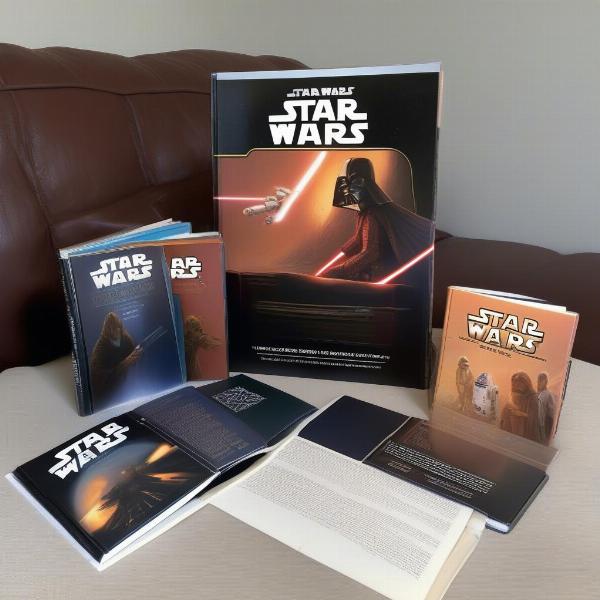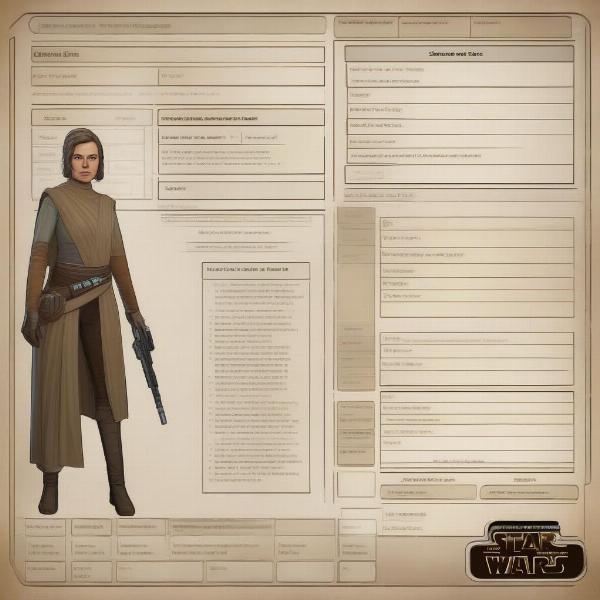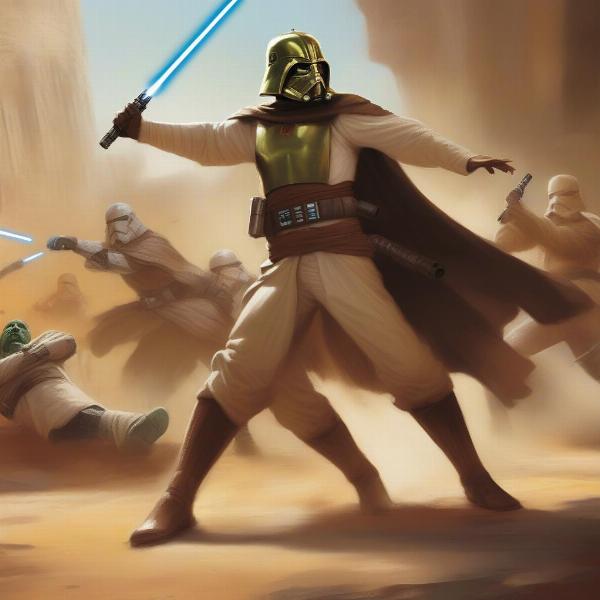Welcome to supremeduelist.blog, where today we’re diving deep into the galaxy far, far away with an in-depth exploration of the Star Wars Roleplaying Game Saga Edition. This system offers a unique approach to storytelling within the Star Wars universe, allowing players to craft their own legends amidst iconic battles and fascinating characters. We’ll explore its mechanics, the tactical depth it offers, and why it remains a favorite among tabletop roleplayers.
This article will break down the core rules of the Saga Edition, discuss its strengths and weaknesses, and provide helpful insights for both newcomers and seasoned players. We’ll also explore strategies for both players and gamemasters (GMs), ensuring a richer and more rewarding experience for everyone. Whether you’re looking to pilot an X-wing, wield a lightsaber, or simply navigate the seedy underbelly of Coruscant, this guide will arm you with the knowledge you need.
What Makes the Star Wars Roleplaying Game Saga Edition Unique?
The Star Wars Roleplaying Game Saga Edition, published by Wizards of the Coast, differentiates itself from other Star Wars RPGs with its streamlined yet comprehensive d20 system. It emphasizes heroic action and cinematic moments, perfectly capturing the feel of the movies. Unlike some RPG systems which focus heavily on simulation and crunch, Saga Edition prioritizes the flow of narrative.
This emphasis on storytelling is evident in its approach to character creation and combat. Players choose from a variety of species and classes, each offering unique abilities and roles within the party. The game simplifies some of the more complex aspects of other d20 systems, focusing on fast-paced action while retaining strategic depth. One of the unique aspects is the focus on “Condition Track”, which provides an abstraction that keeps the narrative moving forward. It is not tied specifically to HP. It is very flexible and can be applied to many things beyond simply health.
 star-wars-saga-edition-core-rulebooks
star-wars-saga-edition-core-rulebooks
A Closer Look at the Core Mechanics
The core mechanic of the Saga Edition revolves around the d20 roll, augmented by skill and feat bonuses. Players roll a d20, add their appropriate modifiers, and compare the result to a target number set by the GM. Successes result in narrative progress, while failures may lead to complications or setbacks. This simple mechanic is easy to grasp for new players, while the depth offered by the numerous feats and talents provides long-term engagement.
One of the crucial features of this system is the Condition Track. Characters don’t just lose health; instead, they accumulate conditions like “Stunned,” “Wounded,” or “Dying.” These conditions impact their abilities, making combat tactical and forcing players to think beyond a simple hack-and-slash approach. This system also facilitates the cinematic nature of Star Wars, where characters might take a blow, get knocked down, but then get back into the fight. This system can be adapted to other situations besides just combat to allow a more flexible storytelling approach for GMs.
Strategic Gameplay and Tactical Combat
The combat system in the Star Wars Roleplaying Game Saga Edition isn’t just about rolling dice; it’s about tactical positioning and teamwork. Utilizing cover, flanking opponents, and strategically applying your character’s abilities become essential to success. The game encourages a collaborative approach, where players work together to overcome challenges, be it against hordes of stormtroopers or a menacing Sith Lord.
Here’s where the different character classes shine, and players must understand and work with each other. The Jedi, with their force powers and lightsaber skills, can control the battlefield. Scoundrels can use stealth and guile, or make the best out of their skills with their blasters. Soldiers can stand toe-to-toe with opponents, dealing massive damage and soaking up hits, while other classes like noble and scout play support roles or deal with situations outside of combat. The tactical decision making in the Saga Edition, especially during large fights, is one of its biggest strengths, keeping the gameplay engaging even for long campaigns.
“The Saga Edition does a fantastic job of making you feel like a hero in the Star Wars universe,” says Dr. Anya Sharma, a prominent game design theorist. “It’s not just about rolling dice; it’s about strategizing and making meaningful choices that impact the story.”
Character Creation: Defining Your Star Wars Hero
Creating a character in Saga Edition is a satisfying process that goes beyond just assigning stats. Players choose a species, which influences initial abilities, and then select a class that determines their skills, talents and role in the group. The various character classes, from Jedi to scoundrels and soldiers, present diverse gameplay styles. The system encourages character customization through the selection of feats and talents, allowing players to fine-tune their characters to fit the story they want to tell.
The system also provides robust guidelines for character background and motivation, encouraging players to develop a backstory that ties into the Star Wars narrative. This attention to detail helps ground player characters in the world and offers the GM unique opportunities to integrate character stories into the larger campaign. One of the reasons many players enjoy this game so much is the ease of designing a character that feels “Star Wars” while still being highly individual.
 star-wars-saga-edition-character-sheet-example
star-wars-saga-edition-character-sheet-example
Gamemastering the Saga Edition: Crafting Epic Adventures
Gamemasters in the Star Wars Roleplaying Game Saga Edition have the tools to craft diverse and engaging campaigns. The system supports a wide range of adventures, from diplomatic missions to large-scale space battles. The GM can customize encounters and challenges to fit the group’s play style and character composition. The system is flexible enough to accommodate a variety of narrative tones, from gritty underworld adventures to grand, heroic sagas.
The rules are structured to make running the game relatively easy, with clear guidelines on NPC creation, combat encounters, and non-combat challenges. The system’s emphasis on narrative means that a GM can easily adapt and improvise when the players make unexpected choices. This flexibility allows the GM to keep the game flowing, while still adhering to a cohesive and engaging storyline. The game also allows for some narrative control, where a GM can introduce special mechanics to make an encounter feel more “Star Wars”.
Tips and Tricks for Players and GMs
For players, understanding the synergies between classes and utilizing the team’s abilities effectively are key to success. Don’t just focus on dealing damage; consider support roles, area control, and tactical maneuvers. Take the time to understand your character’s feats and talents, as they can often provide unique ways to overcome challenges. Don’t hesitate to use the game’s mechanics to be creative, and always think of the best story you can tell.
For GMs, remember that flexibility is key. Don’t be afraid to deviate from the written material. Use the rules as guidelines, but prioritize what makes sense in the context of the story. Focus on creating compelling NPCs that players will care about, and design encounters that challenge them in meaningful ways. The system is more flexible than most, and you shouldn’t be afraid to make it your own. Always ensure that the rules promote the narrative, not hinder it.
“The key to a great game is collaboration between players and the GM,” notes Kenji Tanaka, a veteran tabletop RPG enthusiast. “The Saga Edition provides a framework, but the players and the GM are the ones who bring the story to life.”
Frequently Asked Questions about Star Wars Roleplaying Game Saga Edition
What are the key differences between Saga Edition and other Star Wars RPGs?
Saga Edition uses a streamlined d20 system focused on cinematic action and collaborative storytelling. This distinguishes it from systems focused more on crunchy mechanics.
Is the Saga Edition difficult for beginners?
Not at all. The core rules are easy to grasp, and the game provides ample support for new players and GMs.
How does the Condition Track work in Saga Edition?
Instead of tracking HP directly, the Condition Track introduces conditions that affect a character’s abilities, making combat strategic and story-driven.
Can I play any kind of Star Wars character in the Saga Edition?
Yes. The wide array of species, classes, feats, and talents allows for a high degree of character customization.
What is important for a Gamemaster to remember?
Focus on flexible storytelling that involves the players, use the rules as guidelines, and remember that fun is always the main objective.
Is there a good online community for the Saga Edition?
Yes. There are many online forums and groups dedicated to the game, providing resources and opportunities for finding games.
Why the Star Wars Saga Edition Still Resonates Today
The Star Wars Roleplaying Game Saga Edition continues to be a popular choice for tabletop roleplayers thanks to its engaging gameplay, cinematic feel, and robust system. The flexibility of the system, along with the ample creative possibilities, ensures that each game feels unique and personalized. Whether you are new to RPGs or an experienced veteran, the Saga Edition will provide a fun and enjoyable experience.
The game’s focus on narrative and tactical combat offers a balance that appeals to different types of players. You can enjoy the strategic aspects of combat while also being involved in a story that is both compelling and engaging. If you’re a fan of Star Wars and love collaborative storytelling, the Saga Edition is definitely worth exploring. The easy entry of the system makes it one of the best choices for anyone who is beginning to roleplay, or for veteran RPG players who want to tell exciting stories.
 star-wars-saga-edition-combat-scene-example
star-wars-saga-edition-combat-scene-example
In conclusion, the Star Wars Roleplaying Game Saga Edition remains a high-quality choice for both new players and veterans alike. It provides a unique experience that captures the feeling of Star Wars, giving players a chance to create their own sagas. Remember to check back at supremeduelist.blog for more in-depth analysis and reviews of other games, and get ready to embark on your own adventure in a galaxy far, far away. What are you waiting for? Jump into the Saga Edition and may the Force be with you!
Leave a Reply